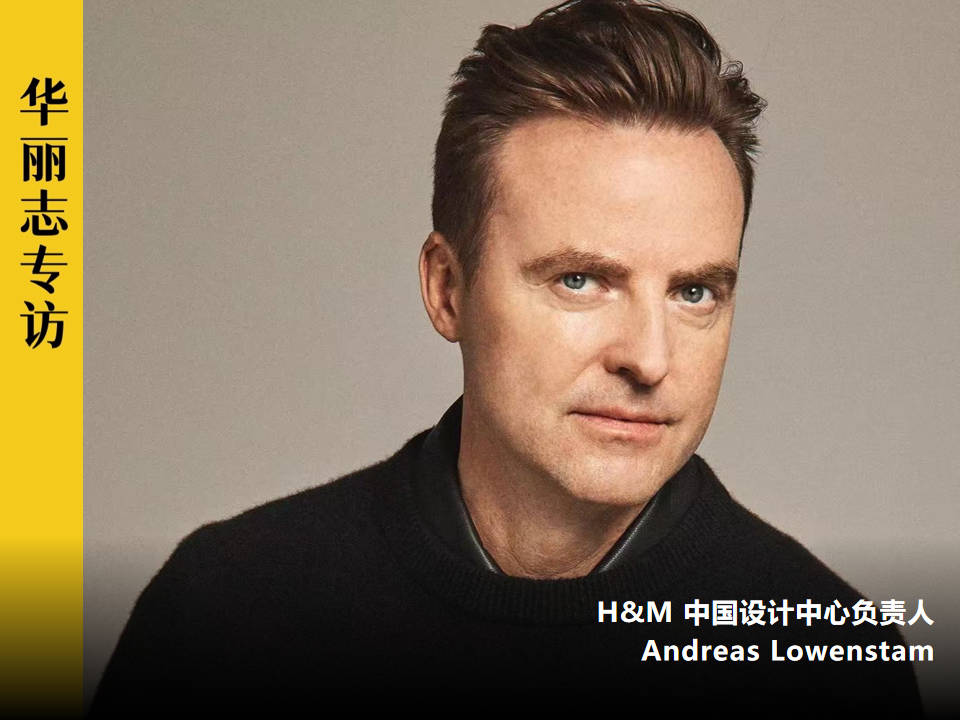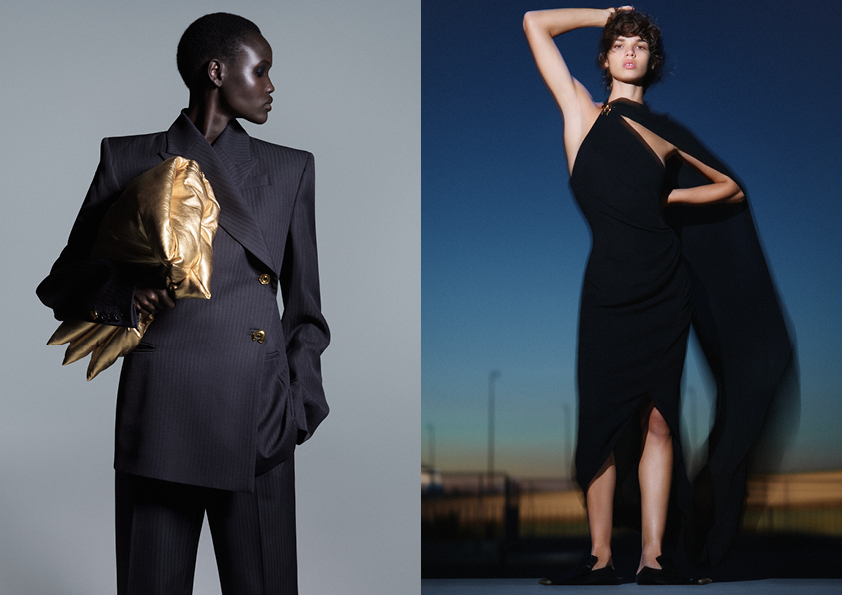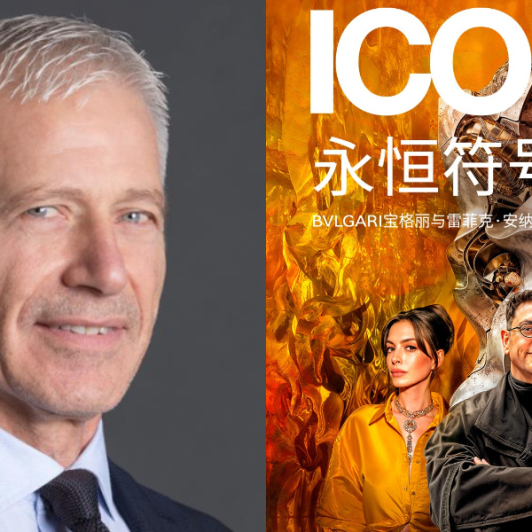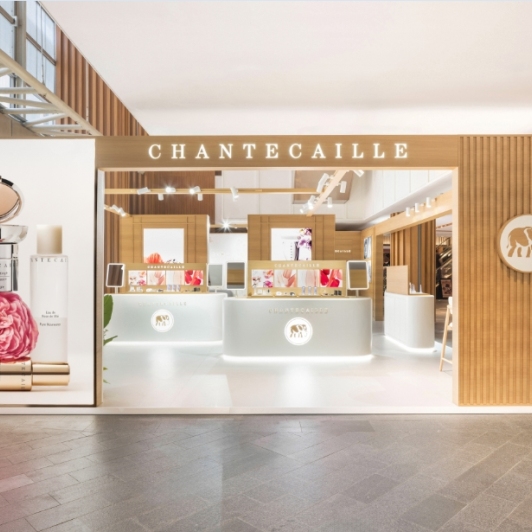H&M is a well-known fashion brand among the Chinese Mainland’s mass consumers, but the Swedish fashion giant is also recognized in the industry for another defining feature: sustainability.
Recently, H&M China Design Center teamed up with the Central Academy of Fine Arts (CAFA), one of the country’s top art education institutions, to launch the “New Design Power—Sustainable Fashion Competition.”
At the event, Luxe.CO engaged in an in-depth conversation with Andreas Lowenstam, Head of H&M China Design Center; Hou Ruoyi, a distinguished lecturer at CAFA; and the competition’s award-winning students.

Andreas Lowenstam (hereafter referred to as “Andreas”) previously directed ARKET’s overall design strategy and product development, successfully establishing its distinctive Nordic style. Later, he was promoted to Head of Menswear Design at H&M, where he led multiple successful collections and design projects.
At the end of 2022, H&M officially established its “China Design Center” in Shanghai. While based in Shanghai, the center serves multiple Asia-Pacific cities, including Japan and South Korea.
As the head of H&M China Design Center, Andreas leads the Shanghai-based design team, focusing on developing fashion styles tailored to the Greater China market.
Andreas emphasized: “For me, the final product is certainly important, but what I value more is providing students with resources and creating a context that inspires different ways of thinking.” He also openly expressed H&M’s strong desire for local talent and creativity: “In China, we are eager to collaborate with local talent and universities.”
During the interview, perspectives were shared from the fashion brand, the university, and the students, shedding light on key questions:
- Why did H&M launch a competition targeting university students?
- Why was sustainability chosen as the theme?
- How does this initiative reflect H&M’s continued investment in the Chinese Mainland market?
“We Are Eager to Collaborate with Local Talent and Universities”
Globally, H&M has collaborated with top international institutions, such as the London College of Fashion (LCF) and the Royal Institute of Technology (KTH).
In the Chinese Mainland, H&M selected CAFA, one of the country’s top-tier art education institutions, to bridge the gap between its brand strategy and the unique Chinese market environment.
The 新设计力——可持续新裳大赛, translated to mean “New Design Power—Sustainable Fashion Competition,” spearheaded by the H&M China Design Center, was open to second-, third-, and fourth-year CAFA students. With sustainability as the central theme, the competition invited students to creatively transform H&M’s inventory products.
Key figures such as Hao Ninghui, Dean of CAFA’s School of Design; Saed El-Achkar, H&M Group President of Retail for the Greater China region; Andreas Lowenstam, and Elisa Wang, Senior Vice President of Luxe.CO, presented awards to the winning students.

This marks the first time in recent years that CAFA’s School of Design has collaborated so deeply with a fashion brand through a competition centered on sustainability.
Hou Ruoyi, a distinguished lecturer from CAFA’s Fashion Design department, was instrumental in guiding students throughout the competition. Leveraging her extensive expertise, she helped spark students’ creativity and inspiration in sustainable design.
Hou stated: “Our institution was likely among the first to systematically incorporate sustainability into our teaching curriculum. We hope that when students design sustainable fashion, it’s truly practical. Collaborating with a company like H&M is immensely valuable.”
The competition’s theme of sustainability reflects the fashion brand’s determination for self-reform and tests students’ ability to express creativity and understand the industry’s future.
Hou remarked: “If this competition can genuinely help a future designer develop a foundation for sustainable thinking, then I believe we’ve done something worthwhile.”

Above: Lecturer Hou Ruoyi (left) with the winner of the “Most Innovative Sustainable Designer Award,” Huang Siyun (right)
The competition, hosted in collaboration with H&M, is a proactive response to the shared aspirations for sustainability in fashion. For H&M, this partnership not only subtly supports the growth of the next generation of design talent but also reflects the brand’s commitment to advancing design and talent cultivation at the forefront of the industry.
Huang Siyun, a doctoral candidate at CAFA, won the competition’s most prestigious accolade, the “Most Innovative Sustainable Designer Award,” for her project titled “Living Poetics: Virtual-Real Cyan Rhythms.” Huang reimagined the patterns and materials of existing garments by leveraging emerging digital technologies. Her design featured dynamic floral installations with mechanical opening and closing structures, challenging the conventional notion of clothing as static. The project demonstrated sustainability from the perspectives of craftsmanship, conceptualization, and cultural significance.
Huang shared her perspective:
“As both a designer and a consumer, I pay attention to different aspects of sustainable fashion and products. From a designer’s perspective, I focus on the entire lifecycle of a product and whether the brand fosters a positive cycle between clothing and people. As a consumer, I evaluate designs based on creativity, a unique aesthetic language, durability, value alignment, and responsible design.”

The winning entries included: “Living Poetics: Virtual-Real Cyan Rhythms” by Huang Siyun – Most Innovative Sustainable Designer Award “The Impossible Wardrobe” by Lin Mingqi – Best Practice Sustainable Designer Award “Alight” by Ma Ying’er – Most Promising Sustainable Designer Award “Black Mirage” by Wang Zhihan – Most Popular Sustainable Designer Award
“We Don’t Need to Compromise for Sustainability”
Andreas Lowenstam, who has been with H&M for nearly 20 years, shared with us the journey of H&M’s transformation toward sustainability over the past decade.
“I first encountered sustainability about 15 years ago, but back then, it largely depended on the personal interests of individual designers. I remember a colleague who self-taught sustainability by reading numerous related articles and implemented the concept by designing jackets made from recycled polyester. He also practiced sustainable living himself.”
“At that time, sustainability was a novel concept for me, but seeing the positive impact of his designs, I realized that sustainability would shape the future. That’s when I started developing an interest in it.”
The rise of the sustainability movement in fashion began in the 1990s. Today, the industry recognizes that sustainability goes far beyond recycling garments or using renewable materials. It challenges brands to undergo comprehensive transformation, starting from their foundational thinking and strategies.
From this perspective, sustainability offers a window into the self-renewal and evolution of fashion brands.
H&M has been a pioneer in sustainability, consistently investing in the space. As a result, its designers now possess a systematic and holistic approach to sustainable design, allowing them to maintain creativity and quality without compromising on sustainability.

Above: H&M’s Innovation Stories collection launched in 2021
“We are a fashion brand, and fashion is our mission. Fortunately, we work for a large company with exceptional resources. We don’t need to compromise on either fashion or sustainability,” Andreas explained.
After more than a decade of development, H&M has established a comprehensive framework for sustainable practices and implementation. Today, all materials used by H&M are sourced sustainably.
“This means my team and I no longer need to request sustainable materials specifically. We can focus purely on creativity, supported by an entire production office ensuring sustainability is not just an option but a fundamental condition.”
Despite over 20 years of development, the acceptance of sustainable concepts and products remains a work in progress in emerging markets like the Chinese Mainland.
Brands must consider how to subtly influence consumers to embrace sustainable ideas and products. H&M’s strategy is to position sustainable materials as the default rather than an option while leveraging creativity and innovation to attract customers.
Winning designs from the competition will be showcased in the windows of H&M flagship stores in cities such as Beijing and Shanghai. Andreas emphasized the importance of practicality:
“We hope to see these garments worn by real consumers, bringing them to life.”
More importantly, H&M uses sustainability as a starting point for experimental innovation, pushing the boundaries of its brand:
- 2012: H&M launched the Conscious Exclusive Collection, focusing on innovation and development. Techniques and fabrics tested through this collection were integrated into the group’s broader operations.
- 2021: This initiative was rebranded as The Innovation Stories, utilizing cutting-edge technology in real-world products.
- 2024: The Innovation Stories will be incorporated into H&M’s premium and most design-driven line, H&M Studio.

Above: H&M Studio 2024 Capsule Collection
For fashion brands like H&M, design is critical to capturing consumer interest. As sustainability becomes a natural consideration for designers, it is seamlessly integrated into the brand’s product offerings.
Beyond products, H&M embeds sustainability across its supply chain, corporate operations, and even financial frameworks. Notably, in 2021, H&M included sustainability in its financial reporting for the first time, formally recognizing it as a key business consideration for the fashion industry.
H&M also actively invests in advancing sustainability within China’s supply chain. In partnership with the Shanghai Electric Central Research Institute, H&M initiated the first carbon-neutral functionality project in China’s textile industry (see image below). The brand provided financial and technical support, enabling one of its suppliers to transition to sustainable energy storage solutions.


“We are a large company, and we aim to be a leader in sustainability. Our message is not just for consumers but for the entire industry,” Andreas stated.
Anchored in sustainability, H&M influences all aspects of the industry value chain. The recent design competition with CAFA exemplifies H&M’s commitment to leveraging its impact for broader industry innovation.
“In the Chinese Market, We Are Open to All Collaborations”
“The H&M China Design Center is an initiative from our headquarters. We want to increase our focus on the Asian fashion market, which is why we decided to establish a design center in Shanghai,” Andreas Lowenstam explained.
The H&M China Design Center brings together Chinese experts in design, prototyping, and production. It not only provides fashion styles tailored to the local market but also serves broader Asian markets, including South Korea and Japan.

As the head of H&M China Design Center, Andreas has been in China for four years and shared his keen observations of Chinese consumers. He noted, “Walking down the streets here, no one dresses in tight pants and fitted T-shirts like in Europe. Everyone’s clothing is more sporty and loose-fitting. Even though Sweden and Stockholm are considered trendsetters, people here are even more daring and ahead in fashion.”
He further emphasized that while the Chinese market is heavily influenced by global trends and international brands, it retains a unique cultural identity. This necessitates a deep understanding of the local market to truly cater to its distinct characteristics and needs.
“For us, it’s important to connect with our customers and consumers, no matter where they are,” Andreas stated, expressing his aspiration to build stronger ties with the Chinese market and its consumers.
Since the establishment of the H&M China Design Center, the company has quickly strengthened its ties with local talent within a year.
For example:
- At last year’s China International Import Expo, H&M announced the launch of the China Design Center and released its first collaborative collection with Chinese artist Yang Wan.
- This October, H&M collaborated with Shanghai Fashion Week to launch the Chinese Designer Brand Collaboration Program, partnering with independent Chinese designer label GARÇON BY GARÇON as its first project.

Above: H&M x GARÇON BY GARÇON Limited-Time Pop-Up Space
“This is just the beginning. There will be a second, third, and fourth… We are open to all collaborations.”
H&M’s focus on supporting and highlighting Chinese design talent stems from its commitment to the Chinese market. The establishment of the China Design Center signals H&M’s dedication to long-term investment and development in the region.
To better connect with Chinese consumers, H&M has made significant strides over the past year:
- Digital: H&M launched online stores on three major e-commerce platforms—JD.com, Pinduoduo, and Douyin—comprehensively expanding its digital presence in China.
- Offline: H&M upgraded its flagship store on Nanjing East Road in Shanghai. Additionally, stores in Beijing Yuehui Plaza, Chengdu Hopson One, Shaoxing Intime City, Guangzhou Zhonghua Plaza, and Shanghai Sun Palace have undergone renovations, offering a fully upgraded shopping experience for consumers.

Above: Renovated H&M Store in Shanghai Sun Palace
Conclusion
For a well-established fashion brand like H&M, sustainability may represent a key opportunity for its next leap forward.
From the perspective of sustainability, H&M’s bold actions demonstrate its relentless drive to innovate and invest in the future. This proactive brand strategy might be the secret to its resilience and long-lasting vitality.
The collaboration with CAFA provides an in-depth look at H&M’s philosophy, values, and vision for the future. It also exemplifies the feasibility of innovative partnerships between universities and fashion brands. At its core, this collaboration reflects H&M’s commitment to sustainability, talent development, and the Chinese market.
| Image Credit: Provided by H&M
| Editor: Zhu Ruoyu



